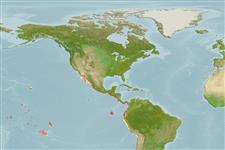Environment: milieu / climate zone / गहराई सीमा / distribution range
पारिस्थितिकी
समुद्री; खारा pelagic-neritic. Tropical; 35°N - 20°S
Eastern Pacific: Mexico to Ecuador. Also reported from Paita, Peru (Ref. 5530).
आकार / वज़न / Age
परिपक्व अवधि: Lm ? range ? - ? cm
Max length : 28.2 cm TL पुल्लिंग / अलिंग; (Ref. 124487); common length : 20.0 cm FL पुल्लिंग / अलिंग; (Ref. 9283); अधिकतम प्रकाशित वज़न: 145.24 g (Ref. 124487)
Body strongly compressed and elongate (depth from 4.5 to 5.4 times in standard length); posterior end of upper jaw reaching middle of eye; upper jaw teeth small and villiform; lower branch of first gill arch with 19 to 22 gill rakers; scales small but visible, needle-shaped, embedded in the skin; back dark gray; belly and flanks silvery or blue gray with yellow highlights; dorsal and anal fins charcoal colored; pelvic fins white; pectoral and caudal fins yellow (Ref. 55763).
Body shape (shape guide): fusiform / normal.
Adults are found in littoral waters (Ref. 9283). They tolerate low salinities and may temporarily penetrate estuarine waters (Ref. 9283). The dorsal and anal spines are connected to venomous glands that can cause painful wounds (Ref. 9283). Marketed fresh and salted or dried (Ref. 9283).
Life cycle and mating behavior
परिपक्व अवधि | पुनरुत्पत्ति | मछलीऔ का अंडे देना | अंडे | Fecundity | लार्वा
Smith-Vaniz, W.F., 1995. Carangidae. Jureles, pámpanos, cojinúas, zapateros, cocineros, casabes, macarelas, chicharros, jorobados, medregales, pez pilota. p. 940-986. In W. Fischer, F. Krupp, W. Schneider, C. Sommer, K.E. Carpenter and V. Niem (eds.) Guia FAO para Identification de Especies para lo Fines de la Pesca. Pacifico Centro-Oriental. 3 Vols. FAO, Rome. (Ref. 9283)
IUCN Red List Status (Ref. 130435: Version 2025-1)
Human uses
मात्स्यिकी: लघु वाणिज्य
साधन
Special reports
Download XML
इंटरनेट स्रोत
Estimates based on models
Preferred temperature (संदर्भ
123201): 20.4 - 29, mean 25.9 °C (based on 288 cells).
Phylogenetic diversity index (संदर्भ
82804): PD
50 = 0.5312 [Uniqueness, from 0.5 = low to 2.0 = high].
Bayesian length-weight: a=0.00708 (0.00435 - 0.01153), b=2.93 (2.79 - 3.07), in cm total length, based on LWR estimates for this species & Genus-body shape (Ref.
93245).
Trophic level (संदर्भ
69278): 4.2 ±0.73 se; based on food items.
लौटाव (संदर्भ
120179): ऊंचा, न्यूनतम जनसंख्या दुगनी समय अवलागत 15 महीने। (Preliminary K or Fecundity.).
Fishing Vulnerability (Ref.
59153): Low vulnerability (18 of 100).
🛈
Nutrients (Ref.
124155): Calcium = 217 [128, 551] mg/100g; Iron = 2.13 [1.22, 4.01] mg/100g; Protein = 19.4 [18.2, 20.6] %; Omega3 = 0.322 [0.175, 0.610] g/100g; Selenium = 32.4 [15.8, 67.9] μg/100g; VitaminA = 35.9 [10.5, 107.6] μg/100g; Zinc = 1.37 [0.94, 1.99] mg/100g (wet weight);
